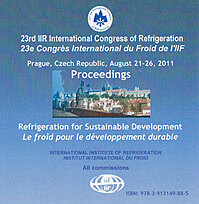
Document IIF
Application d'un interrupteur marche/arrêt double aux systèmes frigorifiques à compression de vapeur.
Application of dual-mode switching control to vapor compression refrigeration systems.
Numéro : pap. ID: 115
Auteurs : OLIVEIRA V., TROFINO NETO A., HERMES C. J. L.
Résumé
This paper explores a novel control strategy for small-capacity (< 1 kW) vapor compression refrigeration systems that is aimed to keep the system running at the optimum performance condition by acting concurrently on the compressor speed and on the expansion valve opening. The controller was designed based on switching control rules obtained using a multiple Lyapunov function approach that guarantees an asymptotic convergence of the system states to a desired point of equilibrium. Tailored experiments for the system identification and controller evaluation exercises (reference tracking, disturbance rejection and energy performance) were carried out using a breadboard refrigeration facility comprised of a variable-speed compressor (VCC), an electric expansion valve (EEV), and two secondary flow rate and temperature controlled brine loops. The switching controller showed to be able to drive the system towards the reference and also to reject the imposed disturbances satisfactorily. Energy performance comparisons considering the proposed controller and a classical dual-SISO approach are also discussed.
Documents disponibles
Format PDF
Pages : 8 p.
Disponible
Prix public
20 €
Prix membre*
Gratuit
* meilleur tarif applicable selon le type d'adhésion (voir le détail des avantages des adhésions individuelles et collectives)
Détails
- Titre original : Application of dual-mode switching control to vapor compression refrigeration systems.
- Identifiant de la fiche : 30001559
- Langues : Anglais
- Source : Proceedings of the 23rd IIR International Congress of Refrigeration: Prague, Czech Republic, August 21-26, 2011. Overarching theme: Refrigeration for Sustainable Development.
- Date d'édition : 21/08/2011
Liens
Voir d'autres communications du même compte rendu (569)
Voir le compte rendu de la conférence
-
Analysis of vapour-compression refrigerating sy...
- Auteurs : SADURNI A., OLIET C., RIGOLA J., et al.
- Date : 21/08/2011
- Langues : Anglais
- Source : Proceedings of the 23rd IIR International Congress of Refrigeration: Prague, Czech Republic, August 21-26, 2011. Overarching theme: Refrigeration for Sustainable Development.
- Formats : PDF
Voir la fiche
-
Application of a Pelton-type expander to replac...
- Auteurs : HE T., LI L. H., XIA C., et al.
- Date : 21/08/2007
- Langues : Anglais
- Source : ICR 2007. Refrigeration Creates the Future. Proceedings of the 22nd IIR International Congress of Refrigeration.
- Formats : PDF
Voir la fiche
-
Caractéristiques de performance d'un refroidiss...
- Auteurs : CHOI J. H., BAEK S. M., MOON C. G., et al.
- Date : 19/03/2009
- Langues : Coréen
- Source : 3e Congrès coréen du froid.
Voir la fiche
-
Climbing the thermodynamic effectiveness summit...
- Auteurs : STAICOVICI M. D. N.
- Date : 21/08/2011
- Langues : Anglais
- Source : Proceedings of the 23rd IIR International Congress of Refrigeration: Prague, Czech Republic, August 21-26, 2011. Overarching theme: Refrigeration for Sustainable Development.
- Formats : PDF
Voir la fiche
-
Determining vapour presence at expansion valves...
- Auteurs : ROCHA M. S., SIMÕES-MOREIRA J. R.
- Date : 21/08/2007
- Langues : Anglais
- Source : ICR 2007. Refrigeration Creates the Future. Proceedings of the 22nd IIR International Congress of Refrigeration.
- Formats : PDF
Voir la fiche
